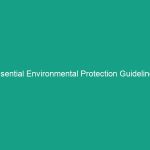Introduction: Welcome to Today’s Toolbox Talk
Good morning team! Today, we’re diving into an important topic that affects not just our work but also the Environment we operate in: Essential Sustainable Building Practices: Guidelines to Ensure Safety. As we strive to create a safer and more sustainable workplace, understanding these practices is crucial. Why? Because Sustainability and Safety go hand in hand. When we prioritize eco-friendly methods, we not only protect our environment but also ensure our health and safety on the job!
Understanding Essential Sustainable Building Practices
So, what exactly are Essential Sustainable Building Practices? In essence, these are strategies and methods aimed at reducing the environmental impact of our construction and building processes while ensuring the safety of all employees involved. This includes everything from using sustainable materials to implementing energy-efficient systems. These practices play a vital role in reducing waste, conserving energy, and promoting a healthier work environment.
Many people mistakenly believe that sustainability is solely an environmental concern, but it directly impacts our daily operations too. For instance, choosing sustainable materials can reduce exposure to harmful substances, leading to a safer workplace.
Key Hazards, Risks, and Safety Considerations
While implementing sustainable building practices, we must also be aware of the potential Hazards and risks involved. Here are some specific challenges:
- Material Safety: Some sustainable materials may still pose risks if not handled properly. For example, while bamboo is a sustainable resource, improper cutting techniques can lead to injuries.
- Energy Efficiency Systems: Installing energy-efficient systems, such as solar panels or high-efficiency HVACs, can introduce Electrical Hazards if not installed correctly.
- Waste Management: Sustainable practices often involve managing waste materials on-site. Poor waste management can lead to slips, trips, and falls.
Ignoring these safety protocols can have real-world consequences, including workplace injuries, increased downtime, and even legal repercussions. That’s why it’s critical to be aware of these risks and take proactive measures to mitigate them.
Best Practices, Procedures, & Actionable Advice
Now, let’s discuss some Best Practices and Procedures to ensure we’re implementing sustainable building practices safely:
1. Proper Training and Education
Ensure that all employees receive proper training on sustainable practices and associated safety protocols. This includes understanding how to handle materials safely and recognizing the risks involved in energy-efficient installations.
2. Use of Personal Protective Equipment (PPE)
Always wear the appropriate PPE when working with sustainable materials or installing energy-efficient systems. This may include gloves, masks, goggles, and hard hats, depending on the task.
3. Safe Material Handling
When transporting sustainable materials, ensure they are secured and handled correctly to avoid accidents. Use proper lifting techniques and equipment to prevent strains and injuries.
4. Waste Management Procedures
Implement a robust waste management plan. This should include:
- Sorting recyclable materials.
- Proper disposal of hazardous waste.
- Regular cleanup schedules to prevent trip hazards.
5. Regular Inspections
Conduct regular inspections of the worksite to identify potential hazards associated with sustainable practices. Address any issues immediately to maintain a safe environment.
Regulations, Standards, and Compliance
Compliance with relevant safety Regulations is critical in maintaining a safe workplace. Key regulations to consider include:
- OSHA Standards: The Occupational Safety and Health Administration (osha) provides guidelines on safe work practices, including those specific to the construction and building industry.
- ISO Certification: The International Organization for Standardization (ISO) sets standards for sustainable practices that can enhance safety and efficiency.
- Local Building Codes: Always comply with local regulations regarding sustainable building practices to avoid legal issues and ensure safety.
Understanding and adhering to these standards not only protects you but also enhances our reputation as a responsible and safety-conscious organization.
Employee Engagement & Discussion
Now, I want to hear from you! Consider these questions:
- What sustainable practices have you observed in our workplace, and how do they contribute to safety?
- Have you encountered any challenges while implementing these practices? How did you address them?
- What additional Safety Measures do you think we could implement to enhance our sustainable efforts?
Your insights are invaluable, and discussing these topics can help us all stay informed and engaged in our safety culture.
Conclusion & Key Takeaways
In summary, implementing Essential Sustainable Building Practices is not just about environmental responsibility; it’s about ensuring safety for all employees. By understanding the hazards, adhering to regulations, and following Best Practices, we can create a safer and more sustainable workplace. Let’s prioritize these practices and commit to being proactive in our safety efforts.
Thank you for your attention and dedication to maintaining our safety standards. Remember, every small action counts towards a safer work environment!


